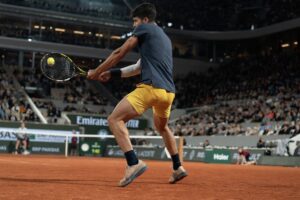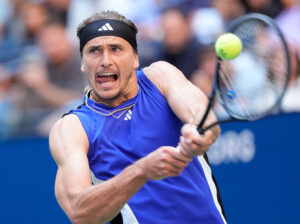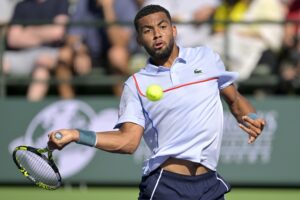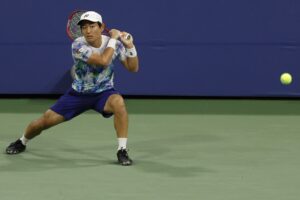Over the years, the US Open has been seen by some as the most difficult major to win. Mainly due to the conditions, the heat, the raucous crowd, late night matches, planes overhead. Plus, the semifinal and final taking place within 24 hours. As the late commentator Bill Threlfall once observed “only the best players win the US Open”. Meaning “one Slam wonders” were rare compared to the three other major tournaments where it was more common.
The Greatest US Open Male Players Of The Open Era
Jimmy Connors
Jimmy Connors is first up on this illustrious as his achievements are simply unmatchable. Unmatchable as Connors is the only player to the win the US Open on three different surfaces. Connors won his first US Open 1974 against Ken Rosewall when the event was held on grass in Forest Hills. Connors won in 1976 on the intriguing surface of green clay defeating Bjorn Borg in four sets. Connors then won on hardcourts in 1978, 1982 and 1983. In 1978 Connors defeated Borg again, then Ivan Lendl twice.
Connors also lost finals in 1975 to Manuel Orantes of Spain and in 1977 to Guillermo Villas of Argentina. A feat which will never be matched as it is unlikely the US Open will change the surface to either green clay or grass. Connors has a unique place in history.
As for Connors the player, Connors was the biggest competitor in the history of Open era tennis, matched only by Rafael Nadal. Connors was a streetfighter in every sense of the word. Connors grew up in Chicago and didn’t learn tennis in a country club but public courts. Connors was not especially tall either at 5 ft 10 (1 metre 78), therefore Connors had to work hard for every point and every win. Connors would usually spin the serve in to start play and hit extremely flat off both wings.
Connors’ big advantage was being left-handed, which helped his serve to open up the court. Connors also attacked the net as often as possible, which we don’t see today in many baseline players. Connors also made a number of semifinal appearance at the US Open throughout the 1970s and 1980s. Overall, Connors played the US Open over a 23 year period from 1969 through 1992 which is incredible. Connors beat some of the greatest players of the Open era. Due to his victories on three surfaces, I put Connors at the top of this list.
Pete Sampras
Like Connors, Pete Sampras has five US Open wins to his name. This puts Sampras on a tie with Jimmy Connors and Roger Federer for the most wins. Sampras does not have the longevity of Jimmy Connors or other players on this list but Sampras has a few unique accomplishments at the US Open which cannot be matched.
At 19 years and 28 days, Sampras is the youngest player to win the US Open. in 1990. Sampras surprised the tennis world that year with probably the most impressive win by a teenager. Sampras defeated Thomas Muster in the fourth round in four sets, defending finalist Ivan Lendl in five sets in the quarterfinal. Sampras then went on to defeat John McEnroe in the semifinal in four sets. And saved his best for Andre Agassi in the final, winning in straight sets. In the final Sampras broke Agassi’s serve on five occasions.
Sampras then lost an entertaining final in 1992 to Stefan Edberg but won in 1993 defeating Cedric Pioline. Sampras then went back to back in 1995 and 1996 defeating fellow Americans Andre Agassi and Michael Chang. Sampras won his fifth title in 2002 again defeating Andre Agassi in four sets in his last match as a professional.
All in all, Sampras’ played 14 US Open tournaments and appeared in 8 finals and two further semifinals. Sampras was virtually a threat every US Open he played. Sampras won the US Open as a teenager, in his 20s and in his 30s. This is matched only by Serena Williams at the Open and Rafael Nadal at the French Open. Sampras also won every night match he played at the US Open, well over 20 matches, also a record. Sampras missed the 1999 US Open with a bad back when he was red hot favourite after amassing a 24 match win streak prior to the event.
As for Sampras’ tennis, he went through quite an evolution at the Open. In his maiden win, he surprised everyone with serve but also return of serve and passing shots. As the 1990s progressed, Sampras liked to stay back a lot, leading to commentators like McEnroe opine that Sampras played too much with a counterpuncher’s mentality. Which most people reading this would find hard to believe.
However, the opening of Arthur Ashe Court in 1997 coincided with Sampras adopting a much more aggressive style. Serve volleying more on 2nd serves and attacking the net more than in the past. The Arthur Ashe court played considerably faster than the previous stadium Louis Armstrong court.
Despite this, Sampras made a strong showing in his last three years, playing three finals in a row. Sampras lost in straight sets to Marat Safin in 2000 and Lleyton Hewitt in 2001. Ironically Sampras beat both players in semifinals in straight sets. Hewitt in 2000 and Safin in 2001. Sampras played in one of the greatest matches in US Open history, the 2001 quarterfinal against Agassi. Sampras biggest achievement might well be winning the title in 2002 with a racquet Leif Shiras described as “should be hung in a museum”. His opponents were using much more modern frames.
Sampras played some of the best tennis ever seen at the US Open. And with 8 final appearances over such a short career span, places him second on this list.
Roger Federer
Roger Federer comes in third on this list, tying with five victories alongside Sampras and Connors. Like Jimmy Connors, Federer has incredible longevity and is the only player here to win five US Open titles in a row between 2004 and 2008. That is a unique record and something to be proud of, unlikely to be matched for some time to come. Federer defeated (destroyed) Lleyton Hewitt in 2004, Andre Agassi in 2005, Andy Roddick in 2006, Novak Djokovic in 2007 and Andy Murray in 2008.
Federer also lost a five-set final to Juan Martin Del Potro in 2009 and four sets to Novak Djokovic in 2015. Federer has made 7 final appearances in total and a number of semifinal appearances. Including 2010 and 2011 when he lost to Novak Djokovic each time after having match points.
Federer is the last in a long line of great players to play a truly attacking game on hardcourts and the US Open. Federer would attack as often as possible, from all areas of the court. Of course, attacking does not necessarily mean attacking the net, but by being aggressive and going for winners, taking the ball early as often as possible, Federer put his opponents under constant pressure.
What is equally impressive is the fact that Federer used a Wilson 90 sq. inch racquet for most of his career up to 2014 when he switched to 97. It is not easy to hit freely with a stiff heavy racquet with a small head and Federer, managed to do it successfully. The quicker court also suited Federer’s game. There is no question that in the last ten years the US Open have put more sand in the deco II courts. Making the courts slower and higher bouncing on average than in the 2000s.
It took time for Federer to make an impression at the US Open. In his first five trips, Federer never made a semifinal appearance, then exploded from 2004 through 2008. In more recent times, Federer has struggled to make an impression, losing to good players but not great players. This is mainly due to age catching up with him, particularly as hardcourts are an unforgiving surface. Taking into account Federer’s marvellous longevity, 7 final appearances over a 21 year period places him third on this list.
Rafael Nadal
Rafael Nadal has won the US Open on four occasions in 2010, 2013, 2017 and 2019. This is incredibly impressive considering Nadal is never thought of as a hardcourt specialist. If Nadal wins this year, he will tie with Connors, Sampras and Federer on five titles.
This year will be difficult as Nadal has been injured since the French Open but there is still a window of two to three more years to achieve this. Nadal struggled in the first few appearances at the Open, during a period when he was seen mainly as a clay court specialist. Things started to improve in 2008 and 2009, when Nadal made the semifinals, losing to Andy Murray and Juan Martin Del Potro respectively.
Nadal made the big breakthrough in 2010, defeating Djokovic in a final lasting 4 hours. Throughout the tournament Nadal showed us something we didn’t see before, a bigger serve with more pace. Nadal lost the final to Djokovic one year later in 2011 but regained the title two years later, again defeating Djokovic. After a few lean years results wise, Nadal came back with a bang in 2017, winning the title defeating Kevin Anderson in the final. And in 2019 Nadal played a final against Daniil Medvedev which lasted almost five hours.
Nadal’s strengths at the US Open is no doubt the lefty serve and forehand. Which has a tremendous amount of revolutions on it. Early on Nadal was susceptible to opponents who could hurt him with aggressive tennis and the backhand down the line in particular. This happened against James Blake and Mikhail Youzhny, two players with a single hand backhand who were able to exploit this. It is a reminder that the stadium court in the 2000s was considerably faster than today, allowing for more enterprising play.
Nadal did his best work during the era of slower courts, but also matured as a player on non-clay surfaces and was ready to win. During the era of the semifinals on Saturdays and the finals on Sunday, often with less than 24 hours turnaround, Nadal would have struggled much more in that environment. Nadal benefitted from the extra days rest at the US Open which started in 2008 due to the continual bad weather and is now standard policy.
John McEnroe
John McEnroe had a stellar career at the US Open, winning four titles and playing in five finals. As a native New Yorker (born in Germany) McEnroe had great home support to draw upon and made a quick impression at major level. In 1977 McEnroe reached the semifinal of Wimbledon as a qualifier and by 1979 McEnroe won his first US Open, defeating Vitas Gerulaitis in an all American final.
McEnroe went on to impressively win three US Opens in a row. Defeating Bjorn Borg in five sets in 1980 and four sets in 1981, hastening Borg’s departure from the grand slam scene. McEnroe then defeated Ivan Lendl in straight sets in the 1984 final but lost his title to Lendl twelve months later in 1985. McEnroe’s results took a downturn in the late 1980s but made one last hurrah in 1990. Where he reached the semifinals but lost to a teenaged Sampras. McEnroe’s game against Sampras looked distinctly underpowered as Sampras reeled off a series of returns and passing shots.
In the early 1980s, McEnroe was a much different player. His ability to take the ball early and redirect the pace was incredible to watch. McEnroe strengths included his lefty serve and instinctive volley game. McEnroe was extremely aggressive, taking returns as early as possible and getting to net at every opportunity, even on a bluff. McEnroe’s transition from wood to the Dunlop Maxply was seamless. But McEnroe didn’t work on his fitness or conditioning and suffered as his career went on.
McEnroe’s work between 1979 and 1985 makes him one of the greatest US Open players. One of the few players to win with both a wood and graphite racquet at Grand Slam level.
Ivan Lendl
Ivan Lendl is definitely up there as one of the greatest. Many older fans may well regard Lendl as the best of the bunch. Primarily because Lendl made an astonishing 8 consecutive finals between 1982 and 1989, winning on three occasions.
Lendl had some very tough opponents. He lost his first two finals in 1982 and 1983 to Jimmy Connors. Then after beating Pat Cash in the 1984 semifinal, part of the fabled “Super Saturday”, Lendl lost in straight sets to McEnroe the next day. However, Lendl gained revenge in 1985, trouncing McEnroe in straight sets. The 1985 final was the first sign of true power tennis which McEnroe couldn’t cope with.
Lendl went on a three final win streak, defeating “the Cat” Miroslav Mecir in 1986 and Mats Wilander in 1987. Mats Wilander would beat Lendl in 1988 and finally a loss to Boris Becker in 1989. An interesting resume of three victories sandwiched between five defeats. The five defeats prevent Lendl going to the top of the list of the greatest US Open players. However, as you can see, he faced some of the very best players in the Open Era. In 1990 Lendl lost to Sampras in five sets and then in 1991 lost out to Stefan Edberg in the semifinal.
In regards to Lendl’s game, tailor made for hardcourts. Lendl is widely credited for helping to bring in the power game and ultra-professionalism. Lendl was the first player to change his racquet with every “new balls”. Lendl also upped fitness training and dietary methods to a new level which forced the younger generation to follow and replicate. Lendl used a racquet even smaller than both Sampras and Federer, this relied on precision as opposed to going all out.
Despite Lendl’s excellent inside out forehand, fitness and powerful serve, Lendl would struggle against both Mats Wilander and attacking players like Becker and Edberg. Lendl had trouble against Wilander because of his reluctance to pull the trigger, instead engaging in too many cagey rallies. Lendl struggled against Becker and Edberg because they attacked him a lot more. Whilst Connors was ultra-competitive which Lendl wasn’t ready to match in 1982 and 1983.
Honorable mentions
Andre Agassi
Andre Agassi had a strong US Open career over a twenty year period, winning in 1994 and 1999, and playing in six finals overall. Agassi lost three finals to Sampras in 1990, 1995 and 2002 and then to Federer in 2005. Agassi beat Michael Stich in straight sets in 1994 and Todd Martin in five sets in 1999.
Agassi could have been one of the greatest but his four losses prevented that. In fact, in each match Agassi lost to Sampras, he went in as favourite on every occasion. This is a minus on Agassi’s otherwise excellent legacy at the US Open.
Novak Djokovic
Djokovic currently has three US Open wins to his name and has the time and capability to add to that tally. Djokovic won so far in 2011, 2015 and 2018 against Nadal, Federer and Del Potro. Djokovic potentially could have been top but has lost a number of finals. Including 2007 as a 20 year old against Federer. Then 2010, 2012, 2013 and 2016. In 2012 Djokovic lost to Murray and in 2016 to Wawrinka who took two slams off him (2015 French Open).
Djokovic has a surprisingly poor record in US Open finals. There is no real explanation as to why this is the case. Djokovic is clearly more vulnerable in New York than he is in Australia on Plexicushion, a surface that rewards consistent play more than any other surface.
Main photo:
Embed from Getty Images






